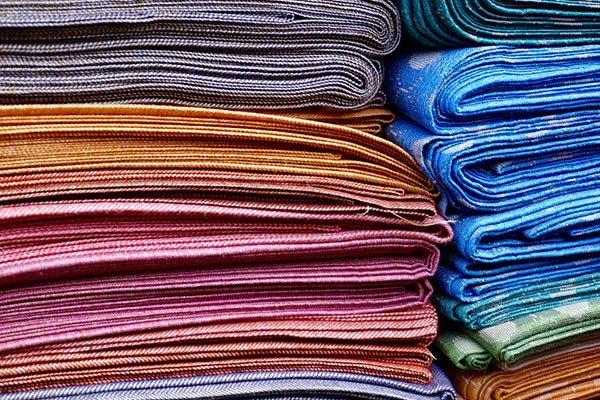The debate between organic and synthetic fibers is an ongoing one among fashion designers, environmental activists, and anyone else interested in what they wear. Both kinds of material come with advantages and disadvantages: Organic cotton is eco-friendly but can be more expensive, while synthetic fibers are less expensive and easier to use in mass production, but might not be best in the long run.
Here is a breakdown of both, and a closer look at the usefulness of each.
Organic cotton
Organic cotton refers to cotton in its purest form. It is naturally cultivated and doesn’t contain any human-made chemicals. In the U.S., organic cotton must be certified and follow strict guidelines set by the National Organic Standards Board and the Organic Foods Production Act, which requires the farming of cotton to be free of pesticides and herbicides.
The organic process
The manufacturing process of organic cotton takes time, because farmers can produce only small amounts of cotton at a time. Farmers must take careful measures to ensure that the cotton is in the best possible condition.
The purity of cotton relies heavily on the picking process. Machine picking damages the cotton fiber, so organic farmers have to hand-pick their cotton.
Handpicked cotton ensures that the fiber is more elongated and undamaged, meaning that organic cotton is stronger and more durable than other cotton. That’s why garments made with organic cotton are much softer than items made from other cotton.
Nonorganic-cotton farmers use a large number of chemicals such as chlorine, heavy metals, and unnatural dyes, which can cause skin allergies and inflame eczema. Organic cotton is 100% free from artificial additives, because organic farmers use water-based dyes and natural whitening agents.

Benefits of organic cotton
Organic cotton is durable, soft, and doesn’t cause skin irritations. It is an excellent material for people with skin conditions. It is also beneficial for babies, as their skins are susceptible to irritation.
Organic cotton garments are breathable and don’t retain odor as much as other materials. It also means that you’ll wash it less frequently.
Organic cotton is also a sustainable material that uses less water than chemical-produced cotton. It is eco-friendly and promotes biodiversity.
Buying organic cotton garments means you are supporting a sustainable initiative. These farms are usually smaller in size, and the workers are paid a fair wage.
What’s the catch?
Organic cotton does have some downsides, as well. It is more expensive than other options, and it isn’t viable for production on a large scale.
Synthetic fibers
Synthetic fibers refer to material created with human-made resources, usually through a chemical process. Due to the limited availability and high cost of organic materials, scientists came up with generic duplicates, which are easier to process and cheaper to mass-produce.
Benefits of synthetic fibers
Synthetic fibers come in different forms, and every day, we take advantage of their benefits.
Organic material can be costly in their pure forms. Luxurious items such as silk and wool can be imitated with synthetic fibers and purchased at a more-reasonable price.
Synthetic material is easier to take care of than organic fibers. Most of these clothing items can be washed in a washing machine and don’t require any special care. This material is also more stain-resistant than natural fibers, which makes it great for everyday use.
Also, synthetic fibers can be manipulated to be completely waterproof and windproof, which makes it useful in harsh weather conditions.
Examples of synthetic fibers
Acrylic
Acrylic is known for its heat retention. It is often used as an imitation for wool, fleece, and fake fur. It is made from polymers formed by acrylonitrile.
Microfibers
Microfibers are particles made up of polyester with a diameter of 10 micrometers or smaller. Cleaning cloth material is the best use for this fiber, thanks to its ability to absorb dirt.
Polyester
Polyester, made from coal and petroleum, is known for its durability. This type of fiber is often combined with other materials because it doesn’t absorb water well. Polyester isn’t breathable, so it isn’t a great material to wear in summer.
Rayon
Rayon is made from refined wood pulp that goes through a chemical process to produce generic silk and wool replicas. It is considered a semi-synthetic fiber because of the natural elements in the process.
Spandex
Spandex is a very elastic material that is made up of different types of blended fibers. This fiber is used most often in athletic wear, underwear, and jeans. Lycra or elastane are other names that spandex goes by.
What’s the catch?
Synthetic fibers do have some disadvantages, too. While they are less expensive than organic materials, the chemicals are harmful to the environment and the products might not last as long.
A healthy balance
Both natural and human-made materials have value in our lives. It isn’t necessary to throw out all of your artificially made clothes; instead, what you need is a healthy balance of both materials.
Look for 100% organic cotton when shopping for new items. These pieces will last longer and be much cooler to wear in the summer months. But it is also essential to keep sustainability in mind when you shop for new clothes. Study the label and be wary of harmful fibers in clothes. You want to buy durable clothes and not cheap ones that won’t last and often end up in the trash.
Also, try to support smaller manufacturers that produce goods on a smaller scale. Their prices might be higher than big distributors, but the clothes’ quality will make it worthwhile.










